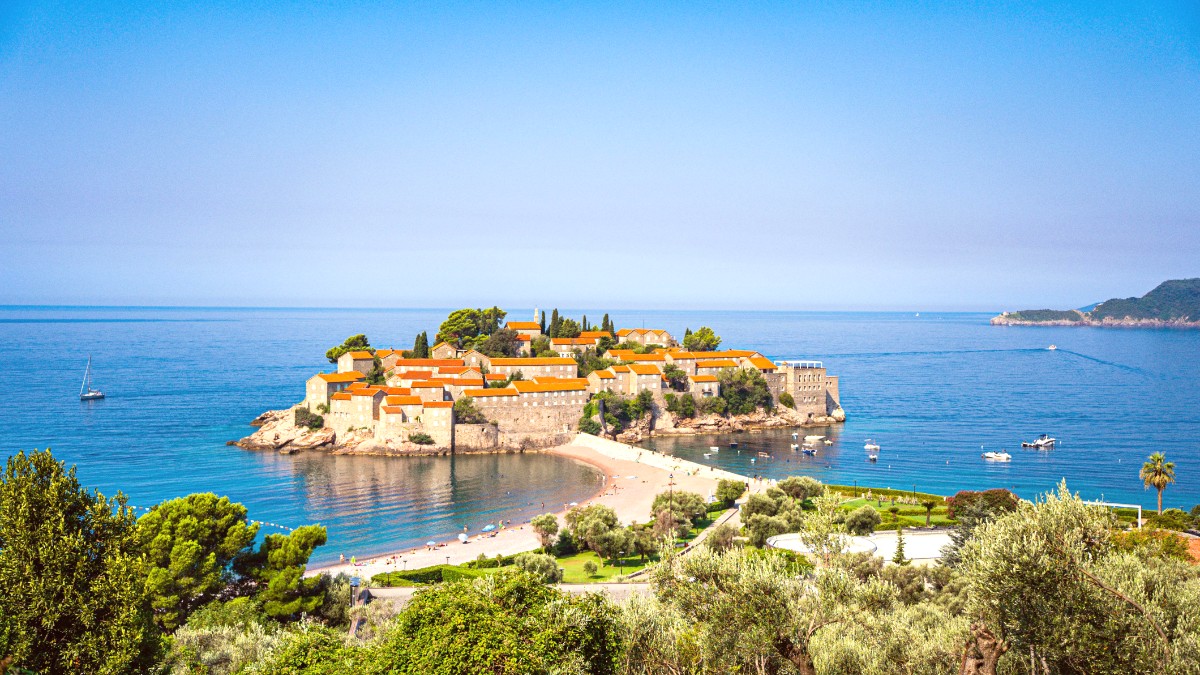
Montenegro
Sveti Stefan lies specifically on Montenegro’s central coast, a region often known as the Budva Riviera. This stretch of coastline has diverse beaches, clear waters, and a mountainous backdrop. The Budva Riviera gently curves, with a mix of sandy stretches and pebbled coves, all framed by the Dinaric Alps. These mountains descend sharply towards the sea, creating dramatic vistas and offering a refreshing contrast to the warm coastal plains.
The islet of Sveti Stefan presents a distinctive feature of this landscape. A natural landform, it is a tombolo, meaning an island connected to the mainland by a narrow strip of sand or shingle. Human intervention over time reinforced this natural bridge, making access simple. The island sits just a few kilometers south of Budva, the Riviera's bustling hub, and north of the quieter town of Petrovac. This positioning allows Sveti Stefan a peaceful escape while remaining within simple reach of more lively centers.
The geography directly influences the climate and activities here. Proximity to the sea brings mild winters and hot summers, great for beach holidays. The surrounding hills and mountains, however, bring cooler air and opportunities for different types of exploration, including hiking or visiting ancient monasteries perched on slopes. The coastal road winds along the entire Montenegrin coast, linking Sveti Stefan to its neighbors and presenting stunning sea views at every turn. This road serves as your gateway to discovering the wider region.
Sveti Stefan’s history holds many layers, like its stone walls. Its origins trace back to 1442. Legend says the Paštrovići clan, a local tribe, built a fortress on this small island after a successful raid on Turkish galleys. They used the spoils to build 12 houses, one for each family, within the fortified walls. This community became a thriving fishing village, positioned strategically for defense against Ottoman and pirate attacks. The islet's name, Sveti Stefan (Saint Stephen), honors its patron saint, whose church stood on the island's highest point.
The 20th century brought great change. In the 1930s, the island served as a summer residence for the Serbian royal family. After World War II, under socialist Yugoslavia, the island community found a new direction. In the 1950s, the remaining inhabitants relocated to the mainland. The entire island then transformed into a luxury hotel-town, a pioneering concept then. Architects and designers meticulously maintained the external appearance of the historic village, converting old houses into modern hotel rooms, apartments, and suites. This transformation kept the islet's historical facade while offering comfort.
Paštrovići clan establishes fortified fishing village.
Resisted invaders, maintained independence.
Serbian royal family summer residence.
Transformed into luxury hotel-town under socialist Yugoslavia.
Leased to Aman Resorts, underwent extensive restoration.
Sveti Stefan swiftly became a playground for the rich and famous. Hollywood stars like Sophia Loren and Elizabeth Taylor, along with monarchs and politicians, sought its exclusive privacy. It was a jewel of the Adriatic, a symbol of Yugoslavia's sophisticated tourism. The era of its socialist glamour peaked in the 1960s and 70s. However, the political turmoil of the 1990s and subsequent economic challenges led to its decline. The resort eventually closed.
After years of dormancy, Sveti Stefan saw a renaissance in the 21st century. The Montenegrin government leased the island to Aman Resorts in 2007, a luxury hotel chain known for its exclusive properties. Extensive restoration followed, and Aman Sveti Stefan reopened, once again welcoming discerning travelers to its unique setting. The restoration kept the village's historic integrity, respecting its ancient walls, narrow streets, and small squares.
Today, the island continues its legacy as a high-end destination, a place where history and luxury meet. Its transformation from a fortified fishing village to an exclusive resort reflects the changing fortunes of Montenegro itself, from a maritime power to a modern tourist destination, all while preserving the timeless beauty of its stone structures.
Image: Sveti Stefan island from mainland, sunset
Sveti Stefan presents a distinct travel experience, blending exclusivity with natural beauty and a relaxed pace. This destination suits visitors seeking a tranquil escape, stunning photo opportunities, and a touch of luxury. The most striking feature is the islet itself, a beautifully preserved medieval village transformed into a renowned resort. Its unique silhouette against the Adriatic Sea defines the local landscape and serves as Montenegro's signature image.
On the mainland, directly opposite the island, Sveti Stefan village brings a more accessible base. Here, charming guesthouses, apartments, and a selection of restaurants offering local cuisine find presence. The atmosphere is calm, a welcome contrast to the more bustling tourist centers along the coast. From the mainland, direct access to beautiful pebble beaches, including Sveti Stefan beach and the serene Miločer Park, where the famed Queen's Beach rests. These areas bring opportunities for swimming, sunbathing, or simply enjoying the captivating coastal scenery.
Stunning views of the Adriatic Sea and surrounding mountains.
World-renowned resort experience on a historic islet.
Gateway to the Bay of Kotor and other coastal treasures.
Sveti Stefan also works well as a starting point for exploring the wider Montenegrin coast. The UNESCO-listed Bay of Kotor, with its fjord-like landscapes and ancient walled towns, also finds easy reach for a day trip. Whether you seek quiet contemplation, romantic dinners with island views, or a base to discover Montenegro’s treasures, Sveti Stefan offers a memorable journey. It promises a blend of Mediterranean charm, historical depth, and natural splendor, all wrapped in a postcard-perfect setting.